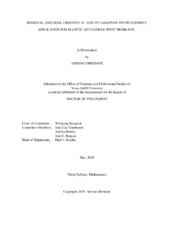| dc.description.abstract | We propose and implement an automatic hp-adaptive refinement algorithm for the Stokes
model problem. In this work, the strategy is based on the earlier work done by Dörfler at al.
in 2007 for the Poisson problem. Similar to any other adaptivity approach, an a posteriori estimator
is needed to control the error in areas with high residuals. We define a family of residual-based
estimators Ŋva a € [0; 1] for the hp-adaptive finite element approximation of the exact solution.
Moreover, we show the reliability and efficiency of the estimators Ŋva. Finally, numerical examples
illustrate the exponential convergence rate of the hp-AFEM in comparison with the h-AFEM.
In many applications, such as analysis of fluid flows in our case, we are not interested in computing
the solution itself, but instead the aim is finding a good approximation for some functional
of interest. In these cases, the idea is to develop some a posteriori error estimates to generate a sequence of h- or hp-adaptive grids that minimize the error in our goal functional with respect to the
problem size. In this work, we apply local averaging interpolation operators such as Scott-Zhang
and Clément type operators to formulate the dual weight of our proposed goal-oriented error estimator. This idea was recently used in an application to the Poisson problem. We extend those
results to saddle-point problems and provide a dual-weighted goal estimator for each cell. The reliability of the goal estimator is proved and numerical examples demonstrate the performance of the locally defined dual-weighted goal-estimator in terms of reliability, efficiency, and convergence.
Another important aspect of this research is providing a goal-oriented adaptive finite element
method for symmetric second-order linear elliptic problems. We prove that the product of primal
and dual estimators, which is a reliable upper bound for the error in the goal functional, decays at
the optimal rate. The results reported in the numerical experiments confirm the quasi-optimality
behavior of our goal-oriented algorithm. | en |


